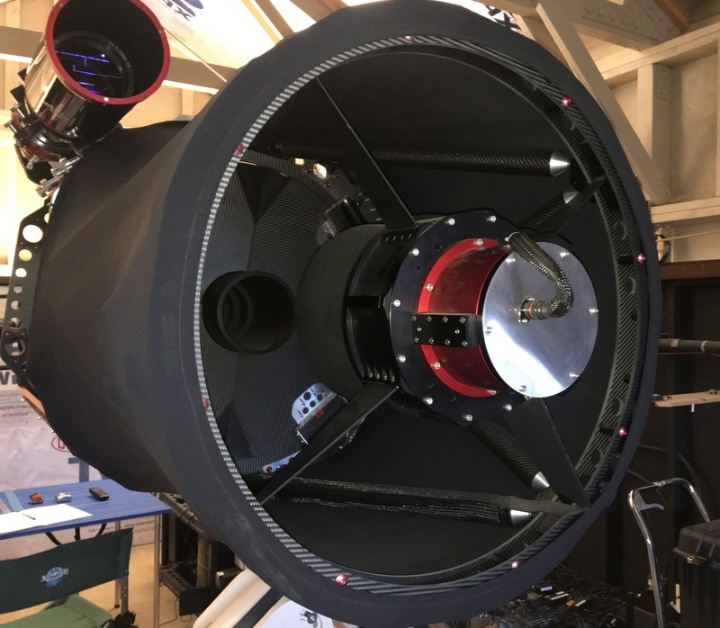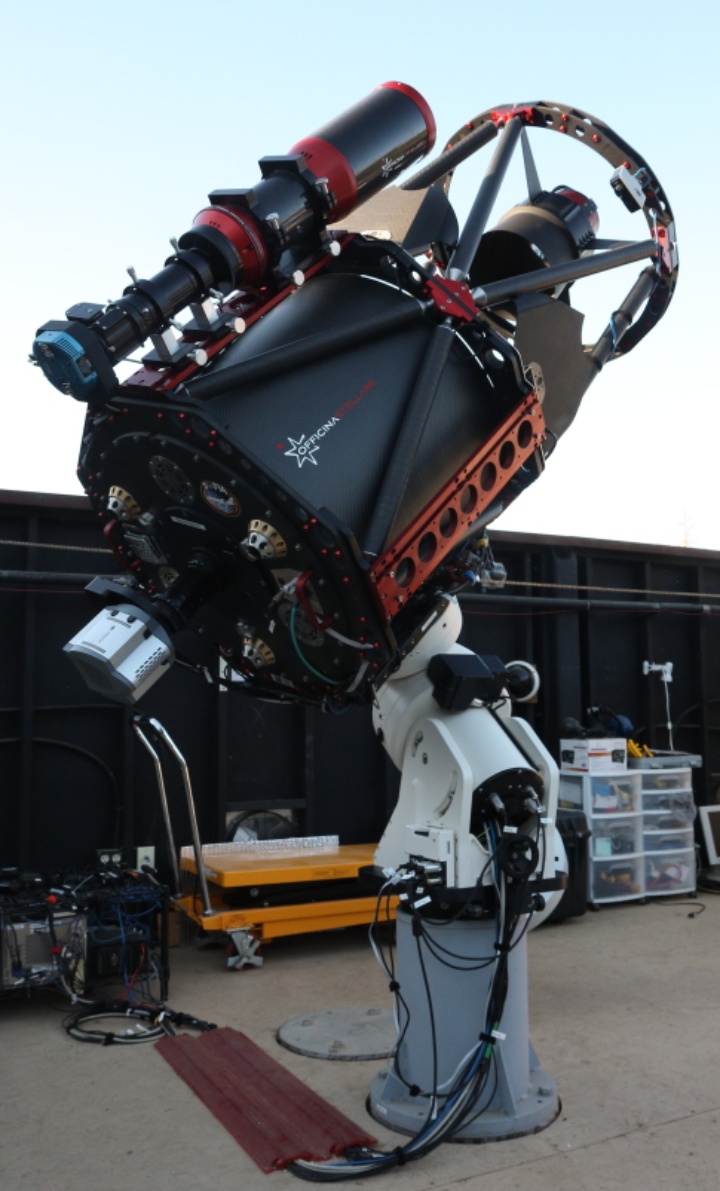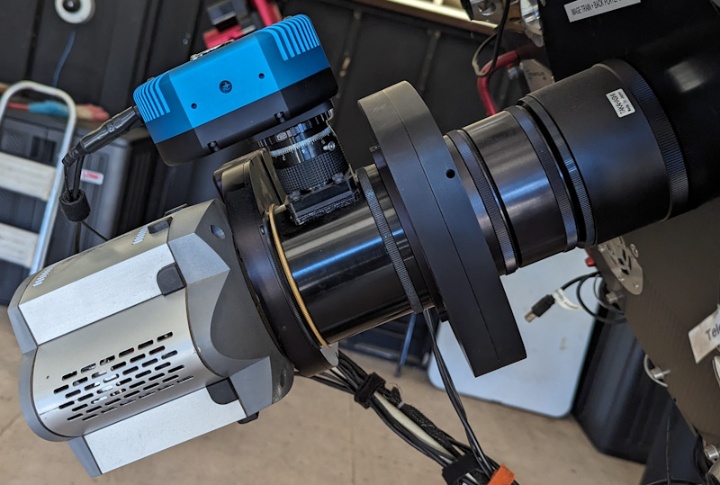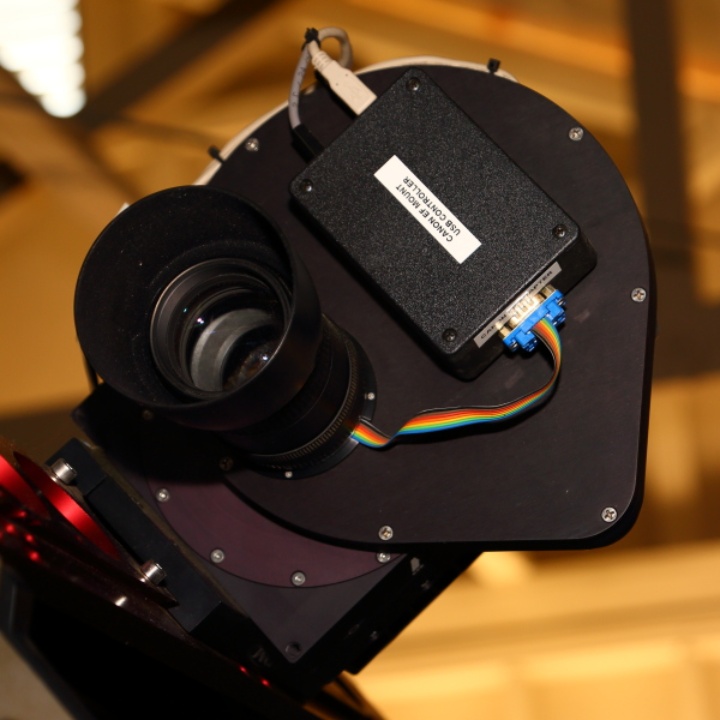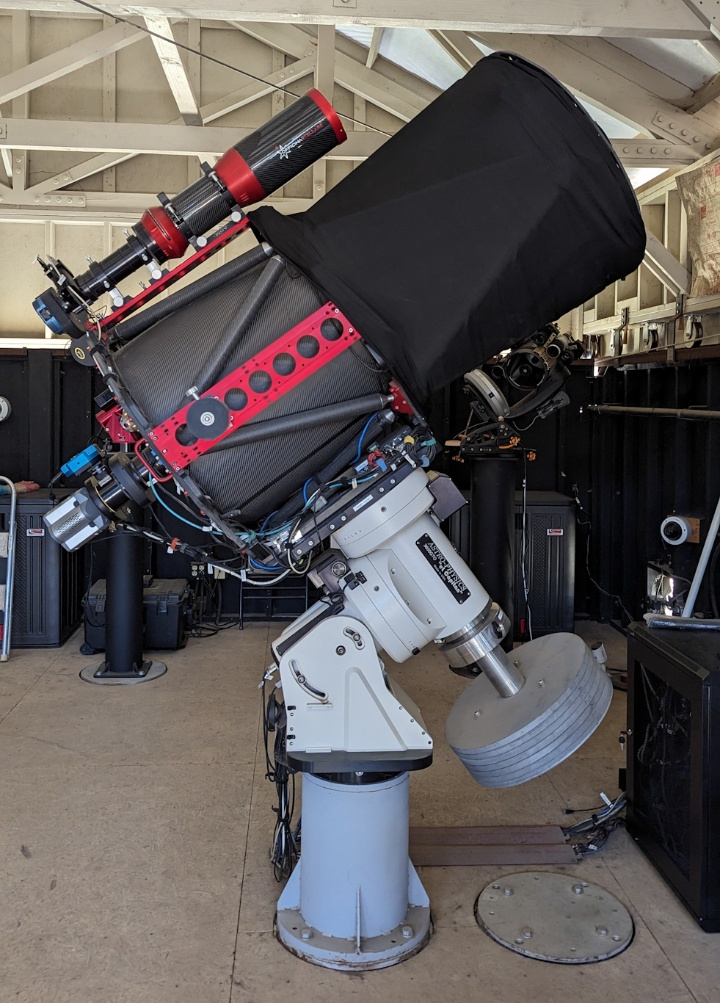
The Astronomical Telescope of the University of Stuttgart (ATUS) was established by the university's Institute of Space Systems (IRS) with support of the Stratospheric Observatory for Infrared Astronomy (SOFIA), funded by the DLR Space Administration. The telescope is managed and operated by the German SOFIA Institute (DSI), a department of the IRS. For the university, the telescope serves as a training platform for aerospace engineering students in basic astronomy and in remote control of complex systems. M.Sc. and Ph.D. students use it as a research instrument for their engineering and astronomy projects. For SOFIA, it is used as a test platform to evaluate new hardware and software before the integration on the airborne observatory. In some cases, the telescope is also used to support SOFIA missions by providing preparatory or parallel measurements of a target or to conduct follow-up observations.
ATUS is a 0.6 meter fully reflective telescope in Ritchey-Chrétien configuration made by Officina Stellare, Italy. Its primary and secondary mirrors are made of the ultra-low-expansion glass ceramics CLEARCERAM-Z HS, supplied by Ohara Corporation, Japan. The primary mirror has a conically shaped backside to reduce its weight. The secondary mirror cell is motorized to shift the mirror along the optical axis for focusing. The optical tube assembly is a dual carbon fiber truss structure with titanium alloy joints. A customized German equatorial mount made by Astro-Physics (AP3600GTOPE) carries the telescope and allows slew speeds of up to 3.75 degrees per second. A precision encoder system at the polar axis of the mount provides nominal guiding accuracy better than 0.5 arcsec over periods of 20 minutes.
The first and primary instrument at the Ritchey-Chrétien focus is a back-illuminated EMCCD camera made by Andor, Belfast combined with a 10-position filter wheel containing a Sloan filter set. The same camera and a similar filter set are used in SOFIA's new Focal Plane Imager (FPI+). It offers high quantum efficiency (ηPeak > 90%), high frame rates and virtually gap free imaging thanks to the sensor's frame-transfer architecture. Very low dark currents are achieved by the camera's thermoelectric cooler that cools the sensor as much as 95 K below ambient. A fully custom designed off-axis guider redirects unused light outside the main camera’s optical beam into a guiding camera made by Quantum Scientific Imaging (QSI) with a front-illuminated KAF-1603ME CCD, enabling ultra-deep exposures and steady tracking with sub-pixel accuracy over hours.
The main telescope is complemented by a piggy-back mounted Wide Field Imager which consists of a ProLine Camera made by Fingerlakes Instrumentation with a back-illuminated e2v CCD47-20 sensor and a commercial 135 mm Canon telephoto lens, focused via a custom Arduino-based interface. This setup is optically similar to SOFIA's Wide Field Imager. A 130 mm f/6 refractor can be used as an imager with an intermediate field size ("Fine Field Imager"), which is particularly useful for satellite tracking and other applications in space situational awareness. It’s camera, also made by QSI, employs a front-illuminated KAF-3200ME CCD.
ATUS is located at Sierra Remote Observatories (SRO) in the foothills of California's Sierra Nevada, a location with seeing conditions in the 1.0 to 1.5 arcsec range in summer. The telescope's control computer and software are set up for remote access via an internet connection. It is remotely operated from the SOFIA Science Center in Moffett Field, California and from Stuttgart, Germany.
ATUS Optical System
|
Optical configuration |
Ritchey-Chrétien |
|
Clear aperture diameter of primary mirror, D |
600 mm |
|
Primary mirror focal ratio |
f/3 |
|
Clear aperture diameter of secondary mirror |
222 mm |
|
Diameter of secondary mirror baffle (central obscuration) |
272 mm |
|
Obscuration ratio, ε |
45.3 % |
|
Obscured area |
20.6 % |
|
Effective focal length, f (nominal) |
4870 mm |
|
Effective focal ratio (nominal) |
f/8 |
|
Diffraction limit, DAiry = 2.44 λ/D |
0.46 arcsec |
Main Camera ("Focal Plane Imager" / FPI)
|
Camera model |
Andor iXonEM+ DU-888E-C00-BV |
||||
|
Sensor type |
e2v CCD201-20, back-illuminated, frame transfer EMCCD |
||||
|
Sensor dimensions |
1024 × 1024 pixel |
||||
|
Pixel size |
13 × 13 µm2 |
||||
|
Field of view on sky |
9.4 × 9.4 arcmin2 |
||||
|
Plate scale |
0.55 arcsec/pixel |
||||
|
Mechanical shutter |
No |
||||
|
Filter wheel |
SBIG CFW-10; 10 positions for 1¼ inch filter cells |
||||
|
Available filters |
- Parfocal Astrodon Sloan 2nd generation filter set (g'2, r'2, i'2, z_s2, Y2) & clear filter (> 395 nm); |
||||
|
Achievable frame rates with... |
no binning |
2x2 binning |
4x4 binning |
||
|
Full frame readout |
8.9 fps |
17.4 fps |
33.5 fps |
||
|
512 x 512 AOI |
17.6 fps |
34.0 fps |
63.9 fps |
||
|
32 x 32 AOI |
205.3 fps |
315.4 fps |
427.3 fps |
||
Off-Axis Guider (OAG)
|
Configuration |
Custom mechanical design with pick-off prism (25 mm edge length, λ/10) redirecting light outside the main camera’s field of view into a separate camera for precision guiding |
|
Camera model |
QSI 616s |
|
Sensor type |
ON Semiconductor (formerly Kodak) KAF-1603ME |
|
Sensor dimensions |
1536 × 1024 pixel |
| Pixel size | 9 × 9 µm2 |
| Field of view on sky | 9.7 × 6.5 arcmin2 |
| Plate scale | 0.38 arcsec/pixel |
| Mechanical shutter | Yes |
| Filter wheel | None |
Guide Scope ("Fine Field Imager" / FFI)
|
Optical configuration |
Apochromatic refractor |
|
Clear aperture diameter |
130 mm |
|
Focal ratio |
f/6 |
|
Camera model |
QSI 632ws-8 |
|
Sensor type |
ON Semiconductor (formerly Kodak) KAF-3200ME; front illuminated, full frame CCD with microlenses and enhanced response towards blue wavelengths |
|
Sensor dimensions |
2184 × 1472 pixel |
|
Pixel size |
6.8 × 6.8 µm2 |
|
Field of view on sky |
65.4 × 44.1 arcmin2 |
|
Plate scale |
1.80 arcsec/pixel |
|
Mechanical shutter |
Yes |
|
Filter wheel |
Integrated in camera; 8 positions for 1¼ inch filter cells |
|
Available filters |
Parfocal filter set, consisting of |
|
Readout speed, unbinned |
2.78 s (full frame) |
Wide Field Imager (WFI)
|
Optical configuration |
Commercial telephoto lens |
|
Focal length, f |
135 mm |
|
Camera model |
Custom FLI ProLine PL4720 |
|
Sensor type |
e2v CCD47-20; back-illuminated, frame transfer CCD |
|
Sensor dimensions |
1024 x 1024 pixel |
|
Pixel size |
13 × 13 µm2 |
|
Field of view on sky |
5.65 × 5.65 deg2 |
|
Plate scale |
19.9 arcsec/pixel |
|
Mechanical shutter |
No |
|
Filter wheel |
FLI CFW-2-7; 7 positions for 50 mm filter substrates |
|
Available filters |
- Parfocal Johnson/Bessel filter set (UBVRI) |
|
Frame rates, unbinned |
1.5 fps (full frame) |
- Sickafoose, A.A., Bosh, A.S., Levine, S.E., Zuluaga, C.A., Genade, A., Schindler, K., Lister, T.A., et al., 2019. A stellar occultation by Vanth, a satellite of (90482) Orcus. Icarus, 319, pp.657–668. DOI: 10.1016/j.icarus.2018.10.016.
- Bosh, A.S., Sickafoose, A.A., Levine, S.E., Zuluaga, C.A., Genade, A., Schindler, K., Lister, T.A., et al., 2018. The 2017 occultation by Vanth: a revised analysis. AAS/Division for Planetary Sciences Meeting Abstracts, 50, p.311.01.
- Sickafoose, A.A., Levine, S.E., Bosh, A.S., Zuluaga, C.A., Person, M.J. & Schindler, K., 2018. Pluto’s atmosphere after New Horizons: results from stellar occultations in 2017 and 2018. AAS/Division for Planetary Sciences Meeting Abstracts, 50, p.502.02.
- Sickafoose, A.A., Bosh, A.S., Levine, S.E., Zuluaga, C.A., Genade, A., Schindler, K., Lister, T.A., et al., 2017. A 2017 stellar occultation by Orcus/Vanth. AAS/Division for Planetary Sciences Meeting Abstracts, 49, p.216.02.
- Bosh, A.S., Zuluaga, C.A., Levine, S.E., Sickafoose, A.A., Genade, A., Schindler, K., Lister, T.A., et al., 2017. Astrometry of the Orcus/Vanth occultation on UT 7 March 2017. AAS/Division for Planetary Sciences Meeting Abstracts, 49, p.216.01.
- Schindler, K., Wolf, J., Bardecker, J., Olsen, A., Müller, T., Kiss, C., Ortiz, J.L., et al., 2017. Results from a triple chord stellar occultation and far-infrared photometry of the trans-Neptunian object (229762) 2007 UK126. A&A, 600, p.A12. DOI: 10.1051/0004-6361/201628620.
- Schindler, K., Lang, D., Moore, L., Hümmer, M., Wolf, J. & Krabbe, A., 2016. Computer-aided star pattern recognition with astrometry.net: in-flight support of telescope operations on SOFIA. Proc. SPIE, 9913, pp.991307-991307–14. DOI: 10.1117/12.2231531.
- Zintz, K., 2015. Stuttgarter Projekt Atus: Ein ferngesteuertes Teleskop für die Uni (Stuttgart’s project Atus: A remotely controlled telescope for the university). Stuttgarter Zeitung, 13 November 2015.
- Timerson, B., Durech, J., Beard, T., McPartlin, C., Morgan, W., Schindler, K., Wolf, J., et al., 2015. Asteroidal Occultation by 82 Alkmene and the Inversion Model Match. Minor Planet Bulletin, 42, pp.129–131.
Pictures of ATUS
